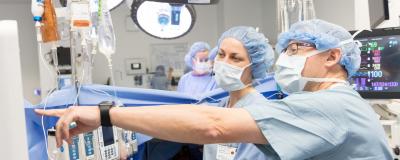History
A male patient presented to the emergency room with severe dyspnea and chest pain. On examination, the patient had hemodynamic instability, malperfusion and EKG changes consistent with an acute myocardial infarction. He had incessant ventricular tachycardia and subsequent cardiac arrest and required cardiopulmonary resuscitation.
The patient had a known history of obesity, hyperlipidemia and poor heart function.
Treatment
With ongoing CPR, the cardiac surgical team assisted in resuscitation and placed the patient on veno arterial extracorporeal membrane oxygenation (ECMO). He underwent cardiac catheterization, revealing critical coronary disease, including left main stenosis.
Subsequently, salvage coronary artery bypass grafting revascularized the patient's critical disease. The ECMO support system was maintained and reconfigured to facilitate rehabilitation and ambulation.
His postoperative course required temporary dialysis for acute kidney injury, prolonged ventilatory support for respiratory failure and endoscopic therapy for gastrointestinal bleeding. With the use of ECMO, his organ function improved. He was liberated from the ventilator and subsequently taken off ECMO support, rehabilitated and recovered cardiac function.
Outcome
The patient benefited from acute rehabilitation. He continues to improve and has now returned to work.
Analysis
ECMO has evolved as an essential resuscitative tool. For patients with cardiopulmonary collapse, the immediate appropriate application has resulted in favorable outcomes in our experience.
This case demonstrates the timely multidisciplinary team that implemented ECMO to stabilize the patient and provide appropriate hemodynamic and pulmonary support during interventions on his heart.
His presentation demonstrates that select patients with catastrophic diseases recover and receive the critical care necessary for optimal outcomes. In general, ECMO demonstrates efficacy in several scenarios, including acute cardiovascular collapse, progressive cardiogenic shock with concomitant pulmonary failure, and post cardiotomy syndrome in those who have failed conventional therapy.
Additional, well-established applications include primary respiratory failure, refractory hypoxemia with PF ratios less than 100, hypercapnic respiratory failure, and as a bridge to transplantation.
ECMO utilization continues to evolve. Appropriate strategies and implementation in the proper patient favor recovery of organ function or utilization as a bridge to transplantation. In addition, RUSH’s survival percentage has exceeded the international average for respiratory and cardiac support for years.

